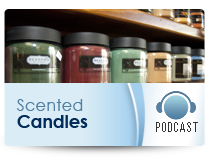[twothirds]
Podcast: Play in new window | Download (Duration: 4:29 — 4.1MB) | Embed
The Good News
According to the National Candle Association, seven our of ten households use candles for decoration and fragrance. They also report that 90% of the purchases are made by women who say they enjoy the beautiful colors, aid to stylish decor and the warm romantic mood the soft glow that a burning candle produces in the room.
The No-So-Good News
Diane Astry, Director of the Health House Project, an American Lung Association project says, “Candles are fast becoming one of the most common unrecognized causes of poor indoor air quality.” The increased interest in aromatherapy, the alternative medicine in which odors are promoted as a relaxation technique, has resulted in a dramatic increase in the use of candles to deliver the “aromas.”
How a Candle Works
Wax is primarily a hydrocarbon, a molecule made of carbon and hydrogen. When you light the wick, the heat from the flame melts the wax, which is then pulled up (this action is called wicking) into the flame. The liquid wax transforms into a gas that becomes the ongoing supply of fuel for the flame.
The discharge from the combustion is made up of carbon, water, carbon dioxide and whatever colorants and fragrances have been added. The water and carbon dioxide dissipate into the air and the carbon particles float away looking for a place to land. This is why wax appears to disappear as it burns.

Here’s the Problem
The wax is not disappearing. It is simply being vaporized into millions of tiny contaminants that are now freely moving around your house. The fact that you don’t notice it happening, doesn’t make it any less unhealthy. The carbon particles are black in color and attach to walls and ceilings where, over time, they become visible. Insurance companies report receiving smoke damage claims that are, in reality, years of candle burning.
But That’s Not All!
Because the wick is the primary point of combustion, it’s important that it remain upright. Traditional wicks are made of braided or twisted plant fiber, (cotton) that has a tendency to droop over under the weight of the wax. The addition of a thin metal core, (lead, zinc or tin) gives the extra rigidity needed.
The obvious problem, Vaporized Lead, resulted in a voluntary ban by the American Candle Association in 1974 and OSHA issued a ban on metal cored wicks in 2003. Unfortunately, many foreign companies choose not to honor the ban, so dangerous candles are sold over web sites and in specialty stores.
 One Last Issue
One Last Issue
Paraffin does not mix readily with the man-made synthetics used to give candles their color, texture, gloss and fragrance. So another family of chemical additives has been created to facilitate the blending and coloring process. The result? An ever-growing and expanding list of polymers, binders and softeners designed to give us cheap, easy-to-make, but unhealthy candles.
So What Are We to Do?
First and foremost is to understand what is burning in your home. Assume that the cheapest candles are probably the most dangerous. Invest a little time in reading labels and asking questions. Invest a little money to purchase candles containing non-toxic soy and beeswax. As a final word, remember that combustion always creates carbon residue which is black, greasy and unhealthy for your body. Anytime you’re burning candles, keep the area well ventilated and use a fewer number to create that warm and romantic mood.
[/twothirds] [onethird_last]
[/onethird_last]





